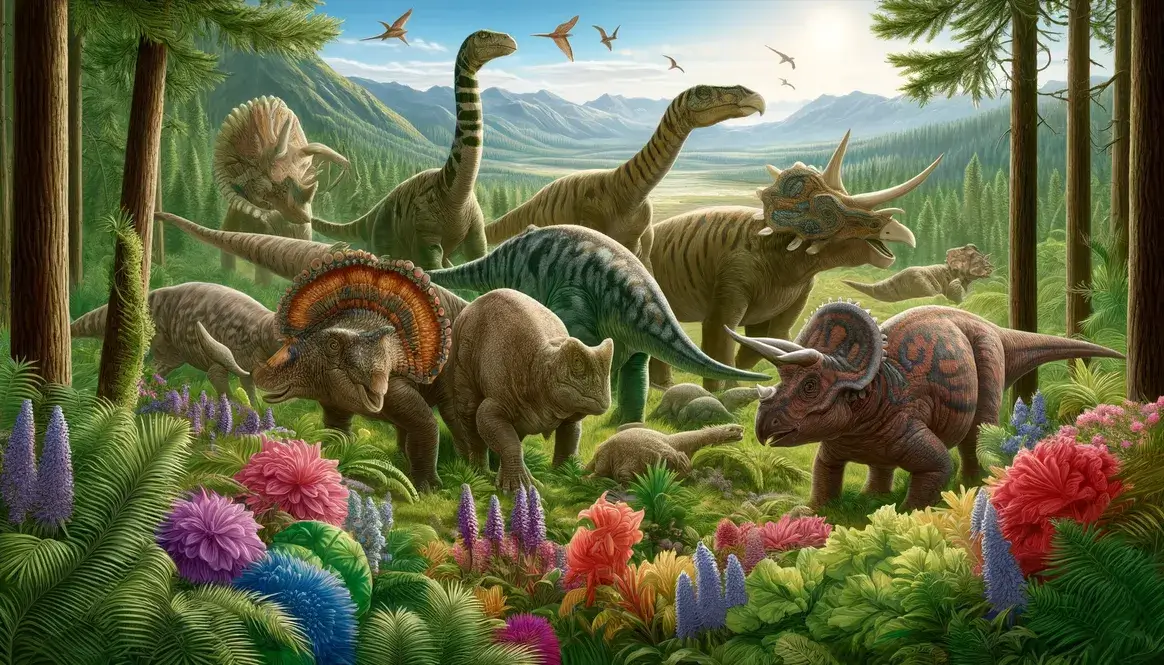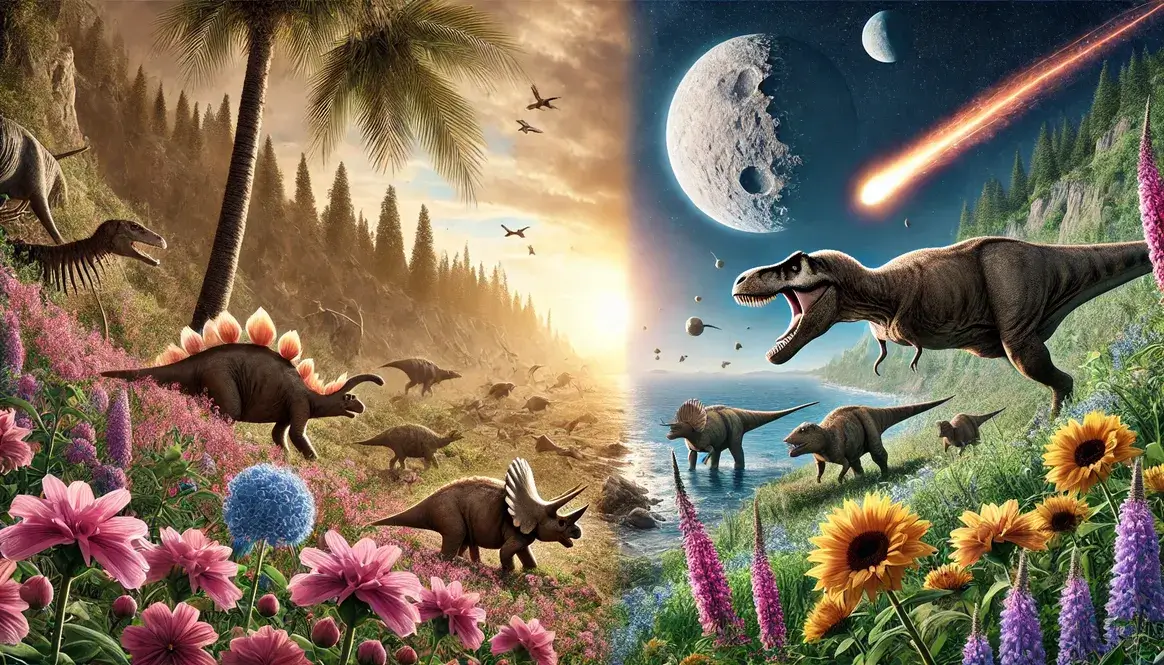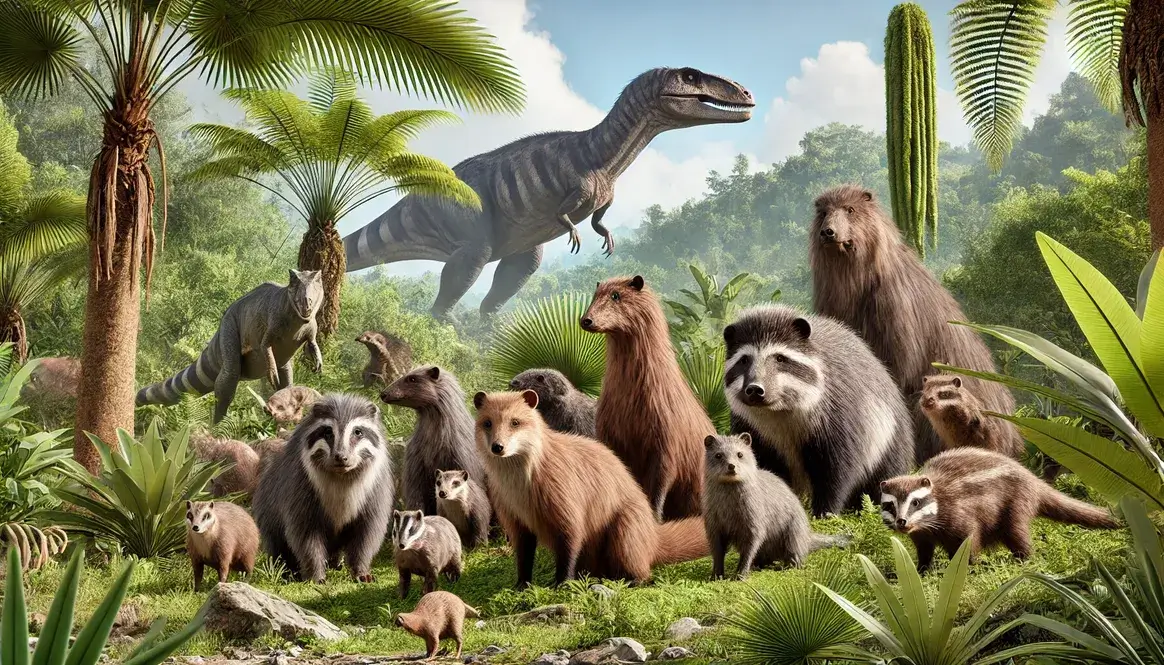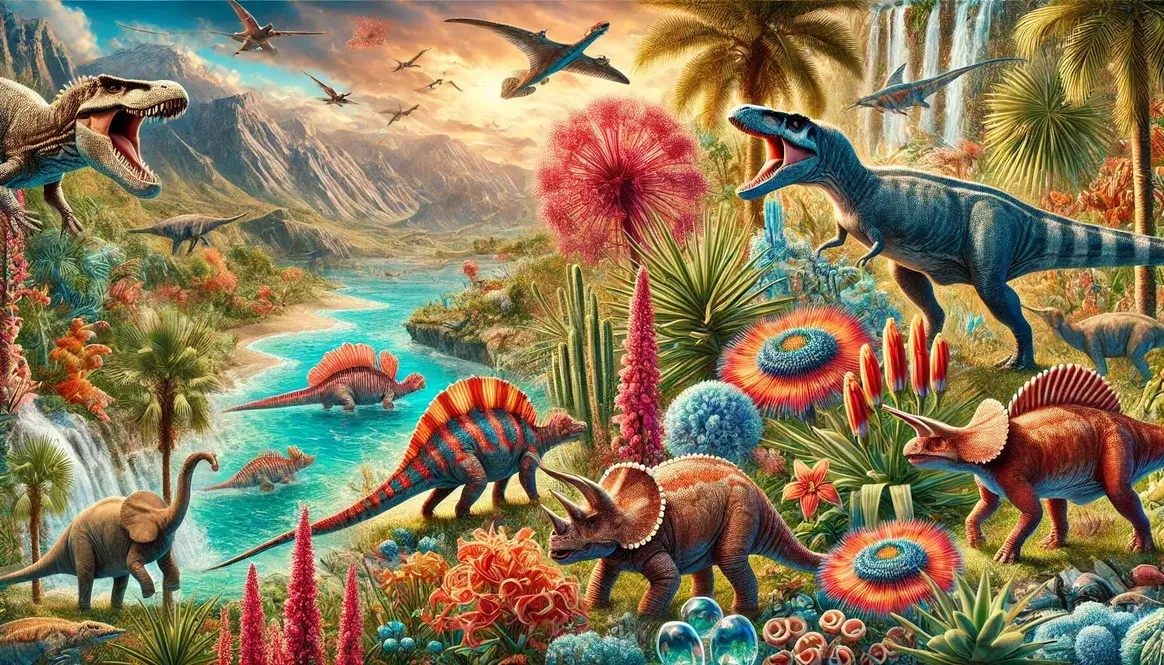The Cretaceous period, spanning from 145 to 66 million years ago, was a time of incredible diversity for plant-eating dinosaurs. These herbivores came in all shapes and sizes, from small, agile runners to massive, lumbering giants. Let’s explore the fascinating world of plant-eating dinosaurs Cretaceous and discover how they spread across the ancient landscapes.
Major Herbivore Groups
During the Cretaceous, several distinct groups of plant-eating dinosaurs roamed the Earth. Each group had its own unique features and adaptations that helped them thrive in their environments. Here’s a quick look at the main players:
- Ornithopods: This group included the famous duck-billed dinosaurs, or hadrosaurs, as well as their ancestors, the iguanodonts. Ornithopods were incredibly successful and diverse, with some species walking on two legs and others on all fours.
- Ceratopsians: Known for their impressive horns and frills, ceratopsians were a group that really stood out. From the small Psittacosaurus to the giant Triceratops, these dinosaurs had a wide range of sizes and horn arrangements.
- Ankylosaurs and Nodosaurs: These were the tanks of the dinosaur world. Covered in bony armor and often sporting clubs or spikes on their tails, these herbivores were built for defense.
- Sauropods: The long-necked giants of the dinosaur world continued to thrive in the Cretaceous. While not as diverse as in earlier periods, sauropods still included some of the largest land animals that ever lived.
| Herbivore Group | Key Features | Example Species |
|---|---|---|
| Ornithopods | Duck-like bills, cheek pouches | Parasaurolophus, Iguanodon |
| Ceratopsians | Horns, frills, beaks | Triceratops, Protoceratops |
| Ankylosaurs/Nodosaurs | Armor plating, tail clubs | Ankylosaurus, Nodosaurus |
| Sauropods | Long necks, column-like legs | Argentinosaurus, Alamosaurus |
Geographical Distribution
Plant-eating dinosaurs in the Cretaceous weren’t confined to one area – they spread out across the globe. As the continents continued to drift apart, different groups evolved and adapted to their local environments.
In North America, you’d find a mix of all these groups. Hadrosaurs and ceratopsians were particularly common, especially in the western parts of the continent. The first flowering plants were also appearing during this time, providing new food sources for these herbivores.
South America was home to some unique titanosaur sauropods, while Europe had its own variety of duck-billed and armored dinosaurs. In Asia, you’d encounter early ceratopsians and some of the last surviving sauropods.
Africa and Australia, which were becoming more isolated, developed their own distinct faunas. Some of the last stegosaurs lived in Africa during the early Cretaceous, while Australia was home to small, quick-footed ornithopods.
This wide distribution meant that plant-eating dinosaurs played crucial roles in ecosystems all over the world. They were key players in the food web, serving as prey for large carnivores like T. rex and its relatives. The variety of plant-eaters also helped shape the plant life of the time, influencing which species thrived and how forests and plains developed.
As we continue our exploration of Cretaceous herbivores, we’ll dive deeper into how these amazing animals adapted to their plant-based diets and the specific features that made them so successful in their ancient world.
Plant-eating Dinosaurs Cretaceous: Adaptations for Herbivory
The Cretaceous plant-eaters were masters of adaptation. They evolved a variety of features that allowed them to munch on tough plant material efficiently. Let’s sink our teeth into the fascinating world of herbivore adaptations!
Dental Adaptations
Cretaceous herbivores had teeth that were perfectly suited for their leafy diets. Here’s how they chomped their way through the prehistoric salad bar:
- Tooth Types: Many herbivores had flat, broad teeth perfect for grinding plant matter. Some, like hadrosaurs, had complex dental batteries with hundreds of teeth packed together.
- Tooth Structure: The enamel on herbivore teeth was often ridged or wrinkled, creating effective grinding surfaces that could break down tough plant fibers.
- Replacement Patterns: Unlike us, dinosaurs could replace their teeth throughout their lives. Some herbivores, like ceratopsians, had a conveyor belt-like system where new teeth constantly grew in to replace worn ones.
This continuous tooth replacement was crucial for herbivores. Plant matter is tough and wears teeth down quickly, so the ability to grow new teeth was a superpower that kept these dinosaurs well-fed.
Skull and Jaw Modifications
Cretaceous herbivores didn’t just have specialized teeth – their entire heads were adapted for plant-eating.
Beaks: Many herbivores, including ceratopsians and hadrosaurs, had beaks at the front of their mouths. These beaks were great for snipping off leaves and stems.
Jaw Mechanics: The jaws of herbivorous dinosaurs were built for power, not speed. They could exert tremendous pressure to crush tough plant material. Some, like the hadrosaurs, had jaws that could move side-to-side as well as up and down, creating a chewing motion similar to modern cows.
| Dinosaur Group | Jaw Adaptation | Function |
|---|---|---|
| Hadrosaurs | Side-to-side jaw movement | Efficient grinding |
| Ceratopsians | Powerful bite force | Crushing tough vegetation |
| Ankylosaurs | Weak bite, strong stomach | Minimal chewing, more gut processing |
Digestive System Adaptations
After all that chewing, Cretaceous herbivores needed efficient ways to process their food. While we can’t observe their soft tissues directly, we can make some educated guesses based on evidence and comparisons with modern animals.
Gastroliths: Many herbivorous dinosaurs swallowed stones, known as gastroliths or “stomach stones”. These stones sat in the dinosaur’s gizzard and helped grind up plant matter, much like in modern birds. Sauropods, in particular, are often found with gastroliths.
Digestive Processes: Scientists think that many herbivorous dinosaurs may have had large, fermenting guts, similar to modern cows. This would have allowed them to break down tough plant material more efficiently.
Some researchers have even suggested that the largest sauropods might have had multiple stomach chambers, like cows, to help them process their enormous intake of plant matter. However, this remains a topic of debate among paleontologists.
These adaptations allowed Cretaceous herbivores to thrive on the plant life of their time, from the newly evolved flowering plants to ancient cycads and conifers. Their ability to efficiently process plant matter helped them grow to enormous sizes and play crucial roles in their ecosystems. In our next section, we’ll meet some of the most notable plant-eaters of the Cretaceous period!
Notable Cretaceous Herbivore Species
The Cretaceous period was home to some of the most remarkable plant-eating dinosaurs ever to walk the Earth. Let’s meet some of these prehistoric celebrities!
Hadrosaurs: The Duck-billed Dinosaurs
Hadrosaurs were among the most successful and diverse herbivores of the Cretaceous. These “duck-billed” dinosaurs came in various shapes and sizes, but two species stand out:
Parasaurolophus was a hadrosaur that couldn’t be missed. Its most distinctive feature was an long, curved crest that extended from the back of its head. This crest wasn’t just for show:
- It may have been used to make loud, trumpet-like calls
- The crest might have helped regulate body temperature
- It could have been a visual signal for mating or species recognition
Parasaurolophus lived in what is now North America about 76-74 million years ago. Its fossils have been found in Cretaceous fossil discoveries across western Canada and the southwestern United States.
Edmontosaurus, on the other hand, was one of the most widespread hadrosaurs. This large, robust dinosaur lacked the flashy head crest of its cousin Parasaurolophus, but it made up for it in size and distribution. Edmontosaurus fossils have been found across North America, from Alberta to Texas, showing how adaptable these plant-eaters were to different environments.
Ceratopsians: The Horned Wonders
Ceratopsians, with their distinctive horns and frills, were some of the most recognizable herbivores of the Cretaceous.
Triceratops: The Icon of the Late Cretaceous
Triceratops is perhaps the most famous of all ceratopsians, and for good reason. This three-horned giant lived right up until the end of the Cretaceous, sharing its habitat with T. rex and other Cretaceous predators.
Key features of Triceratops:
- Three facial horns: two over the eyes and one on the snout
- Large bony frill extending from the back of the skull
- Parrot-like beak for cropping vegetation
- Powerful jaws and teeth for processing tough plant material
Protoceratops: The Ancestor
While not as large or dramatic as Triceratops, Protoceratops played a crucial role in ceratopsian evolution. This sheep-sized dinosaur lived in what is now Mongolia during the late Cretaceous. It had a small frill and a beaked mouth, but lacked the prominent horns of its later relatives. Protoceratops fossils are so common in Mongolia that it’s sometimes called the “sheep of the Cretaceous”!
Armored Plant-eaters
The armored dinosaurs of the Cretaceous were built like living tanks, covered in bony plates and spikes.
Ankylosaurus: The Living Tank
Ankylosaurus was the heavyweight champion of armored dinosaurs. Living in the very late Cretaceous, this dinosaur was covered from head to tail in bony armor. But its most impressive feature was the large club at the end of its tail, which it could swing with tremendous force.
| Feature | Description |
|---|---|
| Body Armor | Bony plates embedded in skin |
| Head | Almost entirely encased in armor |
| Tail Club | Large, bony knob used for defense |
| Size | Up to 6.25 meters long, 1.7 meters tall |
Nodosaurus and its Relatives
While not as well-known as Ankylosaurus, Nodosaurus and its kin were also important armored herbivores. These dinosaurs lacked tail clubs but were covered in bony scutes and spikes. They roamed across North America during the middle to late Cretaceous, using their armored bodies and low-to-the-ground posture to deter predators.
Late Cretaceous Sauropods
Although sauropods had their heyday in the Jurassic, some impressive long-necked giants still roamed during the Cretaceous.
Titanosaurs: The Last of the Long-necks
Titanosaurs were the last great group of sauropods. These enormous herbivores were found on every continent during the Cretaceous. Some, like Argentinosaurus, may have been the largest land animals that ever lived, potentially reaching lengths of 30-40 meters!
Alamosaurus: North America’s Late Cretaceous Giant
Alamosaurus was a titanosaur that lived in North America during the very end of the Cretaceous. It was one of the last sauropods in North America, living alongside famous dinosaurs like T. rex and Triceratops. Despite living in the shadow of the upcoming extinction event, Alamosaurus was no small fry – it could grow to lengths of 30 meters or more!
These notable herbivores showcase the incredible diversity of plant-eating dinosaurs during the Cretaceous period. From the crested hadrosaurs to the heavily armored ankylosaurs, each group had its own unique adaptations that allowed it to thrive in the lush Cretaceous landscapes.
Ecological Roles of Cretaceous Herbivores
Plant-eating dinosaurs weren’t just passive inhabitants of their ecosystems – they were active shapers of the Cretaceous world. Let’s explore how these magnificent creatures influenced and were influenced by their environments.
Impact on Cretaceous Flora
The relationship between Cretaceous herbivores and plants was a two-way street, with each influencing the evolution of the other.
Coevolution with flowering plants
The Cretaceous period saw the rise of flowering plants, or angiosperms. As these new plants spread, herbivorous dinosaurs adapted to eat them, and in turn, the plants evolved defenses against being eaten. This evolutionary arms race led to increasing diversity in both plants and dinosaurs.
Some ways plants adapted to dinosaur herbivory:
- Tougher leaves and stems
- Chemical defenses (toxins or bad tastes)
- Faster growth rates
- More efficient seed dispersal mechanisms
Meanwhile, dinosaurs developed more sophisticated teeth and digestive systems to deal with these new plant defenses. This coevolution helped shape the Cretaceous climate and ecosystems.
Shaping of forest structures
Large herbivores, especially the long-necked sauropods, had a significant impact on forest structure. By feeding on trees at various heights, they created openings in the canopy, allowing light to reach the forest floor. This, in turn, promoted the growth of understory plants, increasing overall plant diversity.
The browsing habits of different herbivores created a mosaic of vegetation types, from open grasslands favored by hadrosaurs to more densely forested areas where ceratopsians might have thrived.
Prey-Predator Dynamics
Herbivorous dinosaurs played a crucial role in Cretaceous food webs as the primary food source for large carnivores.
Herbivores as prey
The abundance of plant-eating dinosaurs supported a diverse array of predators. Large theropods like T. rex and Giganotosaurus relied on herbivores for sustenance. This predator-prey relationship drove evolutionary adaptations on both sides.
| Predator | Preferred Herbivore Prey |
|---|---|
| T. rex | Triceratops, Edmontosaurus |
| Giganotosaurus | Titanosaur sauropods |
| Velociraptor | Protoceratops |
Defensive adaptations and strategies
To survive in a world of fearsome predators, herbivores evolved various defensive strategies:
- Armor: Ankylosaurs and nodosaurs developed extensive body armor and, in some cases, tail clubs.
- Horns and frills: Ceratopsians used their horns for defense and their frills as protective shields.
- Herding behavior: Many herbivores, like hadrosaurs, lived in large herds for safety in numbers.
- Size: Some herbivores, particularly sauropods, grew to enormous sizes that most predators couldn’t tackle.
These adaptations not only helped herbivores survive but also influenced the hunting strategies of predators, creating a complex and dynamic ecosystem.
Ecosystem Engineering
Cretaceous herbivores weren’t just inhabitants of their environments – they were active shapers of the landscape.
Large herbivores, especially sauropods, acted as ecosystem engineers. Their immense size and dietary needs had far-reaching effects on their habitats:
- Vegetation clearance: By consuming vast amounts of plant material, they created clearings in forests, promoting habitat diversity.
- Soil compaction: Their heavy footsteps compacted soil, affecting water retention and plant growth patterns.
- Nutrient cycling: Their droppings distributed nutrients across the landscape, fertilizing plants.
Perhaps one of the most important roles these herbivores played was in seed dispersal. Many plants likely evolved fruits or seeds that could survive passage through a dinosaur’s digestive tract. When the dinosaur deposited its droppings, it might be far from where it ate, spreading the plant’s seeds over a wide area.
This seed dispersal had a profound impact on plant distribution:
- It helped plants colonize new areas
- It increased genetic mixing between plant populations
- It may have contributed to the spread and diversification of flowering plants
By shaping their environments in these ways, Cretaceous herbivores created a world that was more diverse and dynamic. They weren’t just passive participants in their ecosystems, but key players that helped create the rich tapestry of Cretaceous life.
The End of an Era: Herbivores and the K-Pg Extinction
The reign of the great Cretaceous herbivores came to an abrupt end 66 million years ago. The K-Pg extinction event, likely caused by a massive asteroid impact, dramatically reshaped life on Earth. Let’s explore how this event affected our plant-eating dinosaur friends and what their legacy means for us today.
Patterns of Extinction
The K-Pg extinction didn’t affect all dinosaur groups equally. Here’s a breakdown of how different herbivore groups fared:
- Ceratopsians: These horned dinosaurs were hit hard. All known species, including the famous Triceratops, disappeared at the K-Pg boundary.
- Hadrosaurs: The duck-billed dinosaurs also saw a complete extinction. Their diverse array of species vanished from the fossil record.
- Ankylosaurs and Nodosaurs: These armored tanks couldn’t withstand the extinction event. No species are known to have survived.
- Sauropods: The long-necked giants, including the titanosaurs, met their end. However, they were already declining in diversity before the extinction.
Interestingly, smaller herbivorous dinosaurs, particularly those more closely related to birds, had a better chance of survival. This pattern suggests that size played a role in determining which species made it through the extinction event.
Last known herbivorous dinosaur fossils
Some of the youngest non-avian dinosaur fossils come from the Hell Creek Formation in North America. These fossils, including those of Triceratops and the hadrosaur Edmontosaurus, date to within 300,000 years of the K-Pg boundary. This indicates that diverse herbivore communities existed right up until the extinction event.
In other parts of the world, like Europe and Asia, the fossil record becomes sparse in the very late Cretaceous, making it harder to pinpoint exactly when the last herbivores lived in these regions.
Legacy of Cretaceous Herbivores
While the great herbivorous dinosaurs may be gone, their influence lives on in modern ecosystems and in our understanding of ecology.
Influence on modern plant-eating animals
Today’s large herbivores, like elephants and rhinos, fill ecological roles similar to those of Cretaceous dinosaurs. They shape their environments in comparable ways:
- Clearing vegetation
- Dispersing seeds
- Creating pathways used by other animals
However, modern herbivores haven’t quite matched the size and diversity of their Cretaceous counterparts. The extinction of the dinosaurs opened up new opportunities for mammals, leading to the evolution of the diverse herbivore species we see today.
Lessons for understanding current herbivore ecology
Studying Cretaceous herbivores provides valuable insights for modern ecology:
- Ecosystem engineering: The dramatic effects of large dinosaurs on their environments highlight the importance of conserving today’s large herbivores, like elephants, which play similar roles.
- Coevolution: The relationship between Cretaceous plants and herbivores teaches us about the intricate connections in ecosystems. This knowledge is crucial for conservation efforts.
- Climate adaptation: Understanding how herbivorous dinosaurs adapted to changing climates during the Cretaceous can inform predictions about how modern species might respond to climate change.
- Extinction vulnerability: The patterns of extinction among Cretaceous herbivores remind us that even abundant, widespread species can be vulnerable to rapid environmental changes.
| Cretaceous Herbivore Lesson | Modern Application |
|---|---|
| Ecosystem engineering | Conservation of large herbivores |
| Plant-animal coevolution | Understanding ecosystem interconnections |
| Climate adaptation | Predicting responses to current climate change |
| Extinction patterns | Identifying vulnerable species |
In conclusion, while the plant-eating dinosaurs of the Cretaceous are long gone, their legacy lives on. From the way they shaped their ancient worlds to the lessons they teach us about modern ecology, these fascinating creatures continue to influence our understanding of life on Earth. As we face our own era of rapid environmental change, the story of Cretaceous herbivores serves as both a warning and a guide, reminding us of the delicate balance of ecosystems and the profound impacts that large herbivores can have on their worlds.









